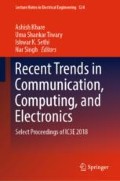Abstract
In this paper, we solve the problem of salient object detection by using an ensemble mechanism of edge detection and active contours. Edge cues are used to provide a solution to the initialisation problem of active contour. The active contour method suffers from the initialisation problem. If the initial contour lies in a region with low probability of salient object, the final salient object detection provides inaccurate results. In this paper, the problem is addressed by generating a binary mask using Sobel edge detection method which acts as the initial contour. The binary mask makes sure that the contour lies in the region with high probability of finding a salient object. This work is an improvement upon the active contour model. The method is simple and fast and follows basic human intuition to find salient objects. The proposed work is compared against seven recent works and gives better results in terms of precision, recall and false positive rates.
Access this chapter
Tax calculation will be finalised at checkout
Purchases are for personal use only
References
Jin-Gang, Y., Xia, G.-S., Gao, C., & Samal, A. (2016). A computational model for object-based visual saliency spreading attention along gestalt cues. IEEE Transactions on Multimedia, 18, 273–286. https://doi.org/10.1109/TMM.2015.2505908.
Zhu, L., Klein, D. A., Frintrop, S., Cao, Z., & Cremers, A. B. (2014). A multisize superpixel approach for salient object detection based on multivariate normal distribution estimation. IEEE Transactions on Image Processing, 23, 5094–5107. https://doi.org/10.1109/TIP.2014.2361024.
Chen, T., Lin, L., Liu, L., Luo, X., & Li, X. (2016). DISC deep image saliency computing via progressive representation learning. IEEE Transactions on Neural Networks and Learning Systems, 27, 1135–1149. https://doi.org/10.1109/TNNLS.2015.2506664.
Borji, A. (2015). What is a salient object a dataset and a baseline model for salient object detection. IEEE Transactions on Image Processing, 24, 742–756. https://doi.org/10.1109/TIP.2014.2383320.
Jian, M., Lam, K.-M., Dong, J., & Shen, L. (2015). Visual-patch-attention-aware saliency detection. IEEE Transactions on Cybernetics, 45, 1575–1586. https://doi.org/10.1109/tcyb.2014.2356200.
Wang, Q., Yuan, Y., & Yan, P. (2013). Visual saliency by selective contrast. IEEE Transactions on Circuits and Systems for Video Technology, 23, 1150–1155. https://doi.org/10.1109/tcsvt.2012.2226528.
Margolin, R., Tal, A., & Zelnik-Manor, L. (2013). What makes a patch distinct? Computer Vision and Pattern Recognition, 1139–1146. https://doi.org/10.1109/CVPR.2013.151.
Jiang, P., Ling, H., Yu, J., & Peng, J. (2013). Salient region detection by UFO uniqueness, focusness and objectness. International Conference on Computer Vision, 1976–1983. https://doi.org/10.1109/ICCV.2013.248.
Cheng, M.-M., Warrell, J., Lin, W.-Y., Zheng, S., Vineet, V., & Crook, N. (2013). Efficient salient region detection with soft image abstraction. In International Conference on Computer Vision (pp. 1529–1536). https://doi.org/10.1109/ICCV.2013.193.
Cheng, M.-M., Mitra, N. J., Huang, X., Torr, P. H. S., & Hu, S.-M. (2015). Detection, global contrast, & region, based salient. IEEE Transactions on Pattern Analysis and Machine Intelligence, 37, 569–582. https://doi.org/10.1109/TPAMI.2014.2345401.
Wei, Y., Wen, F., Zhu, W., & Sun, J. (2012). Geodesic saliency using background priors. In European Conference on Computer Vision (pp. 29–42). https://doi.org/10.1007/978-3-642-33712-3_3.
Yang, C., Zhang, L., Lu, H., Ruan, X., & Yang, M.-H. (2013). Saliency detection via graph-based manifold ranking. Computer Vision and Pattern Recognition, 3166–3173. https://doi.org/10.1109/CVPR.2013.407.
Zhang, J., & Sclaroff, S. (2013). Saliency detection: A Boolean map approach. In IEEE International Conference on Computer Vision (pp. 153–160). https://doi.org/10.1109/ICCV.2013.26.
Liu, Q., Hong, X., Zou, B., Chen, J., Chen, Z., & Zhao, G. (2017). Hierarchical contour closure-based holistic salient object detection. IEEE Transactions on Image Processing, 26, 4537–4552. https://doi.org/10.1109/TIP.2017.2703081.
Author information
Authors and Affiliations
Corresponding author
Editor information
Editors and Affiliations
Rights and permissions
Copyright information
© 2019 Springer Nature Singapore Pte Ltd.
About this paper
Cite this paper
Srivastava, G., Srivastava, R. (2019). An Improved Active Contour Model for Salient Object Detection Using Edge Cues. In: Khare, A., Tiwary, U., Sethi, I., Singh, N. (eds) Recent Trends in Communication, Computing, and Electronics. Lecture Notes in Electrical Engineering, vol 524. Springer, Singapore. https://doi.org/10.1007/978-981-13-2685-1_35
Download citation
DOI: https://doi.org/10.1007/978-981-13-2685-1_35
Published:
Publisher Name: Springer, Singapore
Print ISBN: 978-981-13-2684-4
Online ISBN: 978-981-13-2685-1
eBook Packages: EngineeringEngineering (R0)

